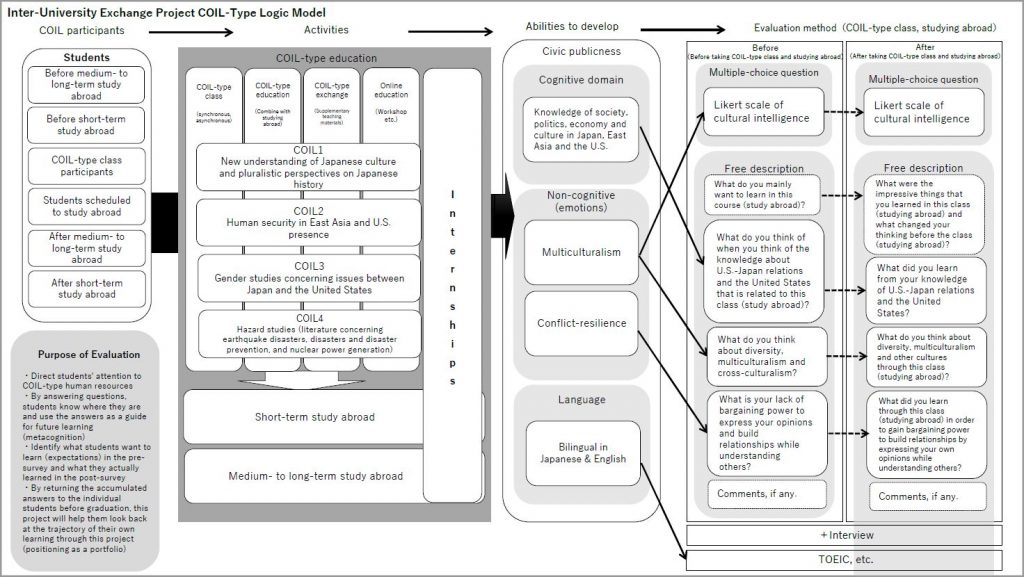TP-COIL Logic model
2019.09.27
In order to nurture students with a civic publicness consisting of multiculturalism sensibility
and conflict tolerance, this project is based on the following logic model.

The “Person subject to the project” on the far left are mainly intended for students who are
planning to study in the partner school for this project for a short or medium term,
participants in COIL type classes, and students who have already studied in the partner
school for this project for a short or medium term.
In the “activities” section, four themes are set as common themes in COIL type education.
COIL1 is “Pluralistic perspectives on Japanese history and new reflections on Japanese
culture”, COIL2 is “Human security and East-Asia and the United States”, COIL3 is
“Comparative gender issues in Japan and the United States”, and COIL4 is “Hazard
Studies through literature. Topics related to natural disasters and disaster prevention, and
to nuclear power in disaster prone areas”. In addition, in line with what was scheduled in
the protocol, “COIL class (Online synchronization, mixing online asynchronous and
synchronous)”, “COIL type education (Coupling with Study Abroad)” which is a package of
study abroad and COIL type education, “COIL Type interaction (supplementary teaching
materials) “as supplementary materials, and” offline education (workshops, etc.) “including workshops, symposiums, and lectures. Based on the COIL type of education, we aim to cultivate the abilities by implementing internships in short-term, medium- and long-term study abroad programs.
As an “ability to cultivate” we are committed to cultivating “civic publicness”. Civic
publicness is achieved by acquiring “Social, political, economic, and cultural knowledge of
Japan, East Asia, and the United States” as knowledge in cognitive fields, cultivating
“multiculturalist sensibility” and “conflict resistance” abilities in non-cognitive fields, and
acquiring TOEIC 800 or higher in bilingual language skills in Japan and the United States.
The “Evaluation method (COIL class and study abroad)” on the far right is used as a
measurement method. Before and after a COIL class or study abroad, we conduct a similar
questionnaire to measure differences between before and after. The purpose of this survey
is as follows. In the preliminary questionnaire, students are asked to pay attention to the
type of human resources they want to develop in this project, and by answering them,
students understand their current position and use the answers as guidelines for future
study (metacognition) and clarify what they want to learn (expectation). An ex-post
questionnaire may clarify what students actually learned and return the accumulated
answers to individual students before graduation to help them reflect on their own learning
trajectories through this project (Portfolio positioning). Responses to multiple-choice
questions are analyzed statistically, and free descriptions are analyzed in a descriptive
manner. Interviews will be conducted as necessary to further clarify the content of the
responses.
The content of the questionnaire is as follows. Regarding “Social, political, economic, and
cultural knowledge of Japan, East Asia, and the United States” as knowledge about East
Asia including Japan and the Trans-Pacific region, the questions are free to describe.
Before the COIL type classes or study abroad, “What kind of knowledge about the
relationship between Japan and the United States and the relationship between Japan and
the United States is something that comes to mind?” and later ” What new learning about
the relationship between Japan and the United States and the United States? “were asked.
In order to measure “multiculturalist sensibility” which is the ability to cooperate and coexist
with people from different cultures, even in different cultural areas, which are sensitive to
cultural and social diversity, we measure intercultural abilities such as cross-cultural
communication ability with the optional “Likert scale for cultural intelligence”. In addition, as
questions for free description, we have established the following questions: “What do you
think about diversity, multiculturalism and cross-culture? (before)” and “What did you think
about diversity, multiculturalism and cross-culture through this class? (later)”. In order to
measure “conflict tolerance “represented by the ability to coordinate interests, negotiate,
and take action with various stakeholders, we set the following questions in the question of
free description: “Where do you think you are lacking in yourself to gain the negotiating
power to build relationships by expressing your opinions while understanding others?
(before)”and “What did you learn through this class (study abroad) in order to gain the
negotiating power to build relationships by expressing your opinions while understanding
others? (later)”. In terms of language skills, proficiency is measured using TOEIC, TOEFL,
IELTS and other English proficiency tests.


